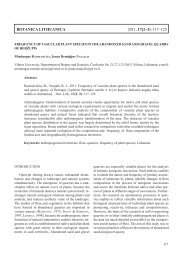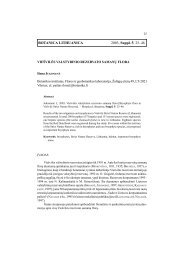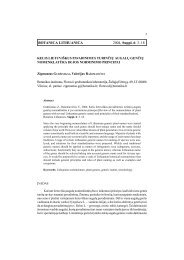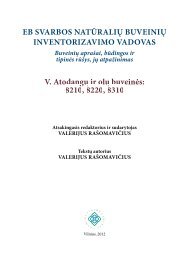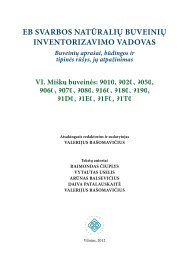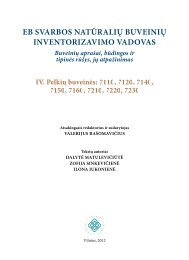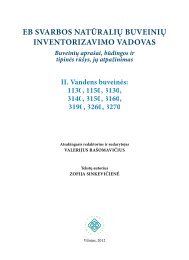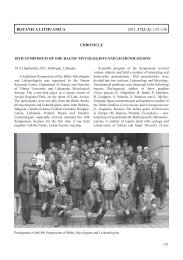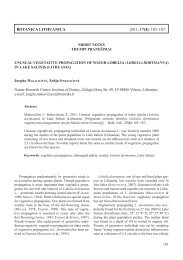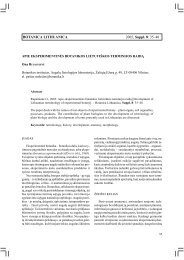FUNGI AND LICHENS IN THE BALTICS AND BEYOND XVIII ...
FUNGI AND LICHENS IN THE BALTICS AND BEYOND XVIII ...
FUNGI AND LICHENS IN THE BALTICS AND BEYOND XVIII ...
You also want an ePaper? Increase the reach of your titles
YUMPU automatically turns print PDFs into web optimized ePapers that Google loves.
Needle extracts did not inhibit the growth of L. seditiosum. Therefore only bark<br />
extracts were used in further experiments. Bark extracts prepared with different extraction<br />
methods were used in present study. Ethanol-based bark extracts in higher concentrations had<br />
stimulating effect on fungal growth but in low concentrations (0.1%) inhibited fungal growth.<br />
Bark extract on the base of sodium hydroxide in 1% and 1.5% concentrations inhibited<br />
mycelial growth. In addition, L. seditiosum isolates of different origins were tested on media<br />
with addition of different extracts.<br />
Interesting aspect was that fungal culture growth forms differed according to extract<br />
added to media – on some extracts fungi formed mycelia mostly on media surface but on<br />
some extracts fungi grew deep into the agar media.<br />
NEW PATHOGENS ON LEAVES OF Alnus spp. <strong>IN</strong> LITHUANIA<br />
S. MARKOVSKAJA<br />
Institute of Botany, Nature Research Center, Laboratory of Mycology, Žaliųjų Ežerų Str. 49,<br />
LT-08406 Vilnius, Lithuania<br />
E-mail: svetlana.markovskaja@botanika.lt<br />
In the mid-1990ies an epidemic of foliar rust affecting alder trees began in Europe.<br />
The agent was identified as new host-alternating rust fungus Melampsoridium hiratsukanum<br />
S. Ito ex Hirats., which for the first time was recorded in Baltic region by the end of 1990ies.<br />
In Lithuania it also appeared around 1998 (according to the first collected specimen preserved<br />
in BILAS herbarium). This Asian rust fungus probably was introduced to Europe with its first<br />
(aecial) host plants Larix spp. and have been rapidly spreading in Europe by the<br />
urediniospores on their second (telial) host plants Alnus spp. Apparently it is a relatively<br />
aggressive pathogen especially for grey alder, which may also infect leaves of more resistant<br />
black alder. During present study we found that M. hiratsukanum is already widely spread in<br />
our country on Alnus incana and started to appear on Alnus glutinosa. In 2010 we found M.<br />
hiratsukanum at the edge of the great cormorant colony (Curonian Spit) strongly affecting<br />
leaves of both A. incana and A. glutinosa. Other pathogen, an eriophyid mite Acalitus<br />
brevitarsus Fockeu (by symptoms resembling rust fungi) was found on Alnus glutinosa leaves<br />
together with the fungus. In the other parts of Curonian Spit and continental Lithuania these<br />
pathogens – the rust fungus and the mite are never found together, this only exception was<br />
recorded in the forest affected by cormorants. The reason for this is that Melampsoridium<br />
hiratsukanum mainly infects leaves of Alnus incana, meantime Acalitus brevitarsus affects<br />
only leaves of A. glutinosa. Evidently, the forest affected by cormorant activity became more<br />
susceptible to pathogens and invasive species.<br />
Acknowledgements. This research was funded by a grant No LEK -23/2010 from the<br />
Research Council of Lithuania.



